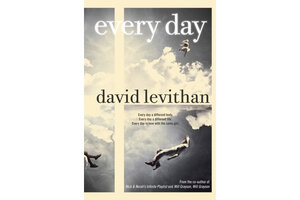Who's buying teen books? Lots and lots of adults
New market research shows that 55 percent of those buying books labeled 'young adult' are in fact 18 and over, a trend that's only been increasing over the past several years.

Some young adult titles, like 'Every Day' by David Levithan, receive critical acclaim that helps them to attract adult readers.
A new study by Bowker Market Research just served to confirm something that many of us already knew: Many of the readers buying books aimed at the teen market are no longer teenagers. But the numbers are more dramatic than we may have guessed. According to the Bowker study, 55 percent of customers who buy young adult books are 18 or older. In fact, the largest group of readers purchasing titles labeled "young adult" are actually 30 to 44 years old – hardly the target demographic for the books.
Of course sometimes parents or grandparents may buy books for young readers but according to the survey, 78 percent of adults who were buying the young adult books said they were buying for themselves, not someone else.
“The extent and age breakout of adult consumers of these works was surprising,” said Kelly Gallagher, Vice-President of Bowker Market Research, in a statement. “And while the trend is influenced to some extent by the popularity of 'The Hunger Games,' our data shows it’s a much larger phenomenon than readership of this single series.”
Suzanne Collins’ dystopian trilogy isn’t the only one that’s gotten adults to wander over to the young adult section. The teen readers genre, which is officially slated for readers 12 to 17, has crossed age lines over the past decade as series like "Harry Potter," "Twilight," and "Hunger Game"s have appealed to adults as well as the younger readers at which they were aimed. The first "Harry Potter" book by J.K. Rowling was released in the United States in 1998, while “Twilight” by Stephenie Meyer was released in 2005 and the first "Hunger Games" book appeared on the market in 2008.
One part of the appeal may be that young adult books are sometimes written in a less complicated fashion than adult books and may offer more of a literary escape than an adult contemporary novel, providing a relaxing experience for an adult reader tired from commuting, working all day, and taking care of kids.
Observers of the book world have been discussing this phenomenon for some time now. Angelina Benedetti, the Washington state librarian, wrote in a 2008 column for the Library Journal that it took her a while to catch on to the quality titles being released in the teen market but that now, when her friends come to her for reading suggestions, she points them to young adult titles.
“It was not until library school that I discovered the wealth of literature published for teens,” she wrote. “In my haste to devour the oeuvre of Margaret Atwood, Barbara Kingsolver, and John Irving, I had missed 'Weetzie Bat'.... For years, my nonlibrarian, non-teen reading friends have come to me asking for ideas because teen books are shorter, faster-paced, and designed to appeal to discriminating readers. They are a quick literary fix without the padding.”
And there’s the simple matter of a book appealing to everyone if it’s written well. While Meyer’s vampire series has been less critically beloved, J.K. Rowling’s "Harry Potter" series and the "Hunger Games" books have been praised for their plots and social satire.
Amazon, in its "best of the month" picks, has included a young adult title in its "Top 10 list" four times so far this year – not on a separate "young readers" list but as part of its overall survey of best titles available. “Every Day” by David Levithan was selected as a September pick, while “Shadow and Bone” by Leigh Burdago made the June list. “The Fault in Our Stars” by John Green cracked the January list and “Daughter of Smoke and Bone” by Laini Taylor made it to the September roll call.

